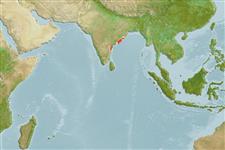>
Eupercaria/misc (Various families in series Eupercaria) >
Nemipteridae (Threadfin breams, Whiptail breams)
Etymology: Parascolopsis: Greek, para in the side of + Greek, skolos = stake + Greek, ops = appearance (Ref. 45335).
Eponymy: Dr Marinus Boeseman (1916–2006) was a Dutch ichthyologist, working in the Department of Zoology, Rijksmuseum van Natuurlijke Histoire, Leiden, becoming Curator of Fishes (1947–1981). [...] (Ref. 128868), visit book page.
Environment: milieu / climate zone / depth range / distribution range
Écologie
marin démersal; non migrateur; profondeur 150 - 300 m (Ref. 28016). Tropical; 20°N - 14°N, 80°E - 86°E (Ref. 3810)
Eastern Indian Ocean: known only from a single specimen collected off Waltair, India.
Taille / Poids / Âge
Maturity: Lm ? range ? - ? cm
Max length : 9.7 cm SL mâle / non sexé; (Ref. 122102); poids max. publié: 2.50 g (Ref. 122102)
Épines dorsales (Total) : 10; Rayons mous dorsaux (Total) : 9; Épines anales: 3; Rayons mous anaux: 7. Head scales reaching forward to level of posterior nostrils. Posterior margin of preopercle more or less vertical. Lower limb of preopercle naked. Posterior margin of suborbital finely denticulate. Pectoral and pelvic fins long, reaching to beyond level of anus. Axillary scale present. Color: Body rosy-yellow.
Occurs on sand or mud bottoms in offshore waters. Feeds mainly on benthic invertebrates. No major fishery exists.
Life cycle and mating behavior
Maturité | Reproduction | Frai | Œufs | Fécondité | Larves
Russell, B.C., 1990. FAO Species Catalogue. Vol. 12. Nemipterid fishes of the world. (Threadfin breams, whiptail breams, monocle breams, dwarf monocle breams, and coral breams). Family Nemipteridae. An annotated and illustrated catalogue of nemipterid species known to date. FAO Fish. Synop. 125(12):149p. Rome: FAO. (Ref. 3810)
Statut dans la liste rouge de l'IUCN (Ref. 130435: Version 2024-2)
Menace pour l'homme
Harmless
Utilisations par l'homme
Pêcheries: intérêt commercial mineur
Outils
Articles particuliers
Télécharger en XML
Sources Internet
Estimates based on models
Preferred temperature (Ref.
123201): 11.9 - 16.6, mean 12.9 °C (based on 7 cells).
Phylogenetic diversity index (Ref.
82804): PD
50 = 0.5002 [Uniqueness, from 0.5 = low to 2.0 = high].
Bayesian length-weight: a=0.01445 (0.00683 - 0.03057), b=2.98 (2.81 - 3.15), in cm total length, based on LWR estimates for this (Sub)family-body shape (Ref.
93245).
Niveau trophique (Ref.
69278): 3.5 ±0.37 se; based on food items.
Résilience (Ref.
120179): Haut, temps minimum de doublement de population inférieur à 15 mois (Preliminary K or Fecundity.).
Fishing Vulnerability (Ref.
59153): Low vulnerability (10 of 100).
